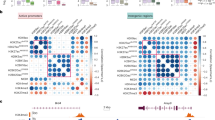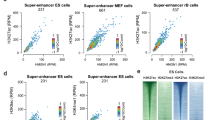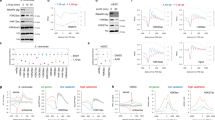Abstract
Histone acetylation is generally associated with active chromatin, but most studies have focused on the acetylation of histone tails. Various histone H3 and H4 tail acetylations mark the promoters of active genes1. These modifications include acetylation of histone H3 at lysine 27 (H3K27ac), which blocks Polycomb-mediated trimethylation of H3K27 (H3K27me3)2. H3K27ac is also widely used to identify active enhancers3,4, and the assumption has been that profiling H3K27ac is a comprehensive way of cataloguing the set of active enhancers in mammalian cell types. Here we show that acetylation of lysine residues in the globular domain of histone H3 (lysine 64 (H3K64ac) and lysine 122 (H3K122ac)) marks active gene promoters and also a subset of active enhancers. Moreover, we find a new class of active functional enhancers that is marked by H3K122ac but lacks H3K27ac. This work suggests that, to identify enhancers, a more comprehensive analysis of histone acetylation is required than has previously been considered.
This is a preview of subscription content, access via your institution
Access options
Subscribe to this journal
Receive 12 print issues and online access
$209.00 per year
only $17.42 per issue
Buy this article
- Purchase on Springer Link
- Instant access to full article PDF
Prices may be subject to local taxes which are calculated during checkout





Similar content being viewed by others
Accession codes
Primary accessions
Gene Expression Omnibus
Referenced accessions
Gene Expression Omnibus
Sequence Read Archive
References
Wang, Z. et al. Combinatorial patterns of histone acetylations and methylations in the human genome. Nat. Genet. 40, 897–903 (2008).
Kim, T.W. et al. Ctbp2 modulates NuRD-mediated deacetylation of H3K27 and facilitates PRC2-mediated H3K27me3 in active embryonic stem cell genes during exit from pluripotency. Stem Cells 33, 2442–2455 (2015).
Creyghton, M.P. et al. Histone H3K27ac separates active from poised enhancers and predicts developmental state. Proc. Natl. Acad. Sci. USA 107, 21931–21936 (2010).
Rada-Iglesias, A. et al. A unique chromatin signature uncovers early developmental enhancers in humans. Nature 470, 279–283 (2011).
Tropberger, P. & Schneider, R. Scratching the (lateral) surface of chromatin regulation by histone modifications. Nat. Struct. Mol. Biol. 20, 657–661 (2013).
Neumann, H. et al. A method for genetically installing site-specific acetylation in recombinant histones defines the effects of H3 K56 acetylation. Mol. Cell 36, 153–163 (2009).
Di Cerbo, V. et al. Acetylation of histone H3 at lysine 64 regulates nucleosome dynamics and facilitates transcription. eLife 3, e01632 (2014).
Daujat, S. et al. H3K64 trimethylation marks heterochromatin and is dynamically remodeled during developmental reprogramming. Nat. Struct. Mol. Biol. 16, 777–781 (2009).
Tropberger, P. et al. Regulation of transcription through acetylation of H3K122 on the lateral surface of the histone octamer. Cell 152, 859–872 (2013).
Simon, M. et al. Histone fold modifications control nucleosome unwrapping and disassembly. Proc. Natl. Acad. Sci. USA 108, 12711–12716 (2011).
Heintzman, N.D. et al. Distinct and predictive chromatin signatures of transcriptional promoters and enhancers in the human genome. Nat. Genet. 39, 311–318 (2007).
Ernst, J. et al. Mapping and analysis of chromatin state dynamics in nine human cell types. Nature 473, 43–49 (2011).
Bogu, G.K. et al. Chromatin and RNA maps reveal regulatory long noncoding RNAs in mouse. Mol. Cell. Biol. 36, 809–819 (2015).
Halley, J.E., Kaplan, T., Wang, A.Y., Kobor, M.S. & Rine, J. Roles for H2A.Z and its acetylation in GAL1 transcription and gene induction, but not GAL1-transcriptional memory. PLoS Biol. 8, e1000401 (2010).
Tie, F. et al. Trithorax monomethylates histone H3K4 and interacts directly with CBP to promote H3K27 acetylation and antagonize Polycomb silencing. Development 141, 1129–1139 (2014).
Whyte, W.A. et al. Master transcription factors and Mediator establish super-enhancers at key cell identity genes. Cell 153, 307–319 (2013).
Zentner, G.E., Tesar, P.J. & Scacheri, P.C. Epigenetic signatures distinguish multiple classes of enhancers with distinct cellular functions. Genome Res. 21, 1273–1283 (2011).
Voigt, P., Tee, W.W. & Reinberg, D. A double take on bivalent promoters. Genes Dev. 27, 1318–1338 (2013).
Long, H.K. et al. Epigenetic conservation at gene regulatory elements revealed by non-methylated DNA profiling in seven vertebrates. eLife 2, e00348 (2013).
Andersson, R. et al. An atlas of active enhancers across human cell types and tissues. Nature 507, 455–461 (2014).
Pefanis, E. et al. RNA exosome-regulated long non-coding RNA transcription controls super-enhancer activity. Cell 161, 774–789 (2015).
Jiang, J. et al. A core Klf circuitry regulates self-renewal of embryonic stem cells. Nat. Cell Biol. 10, 353–360 (2008).
Mali, P. et al. RNA-guided human genome engineering via Cas9. Science 339, 823–826 (2013).
Konermann, S. et al. Optical control of mammalian endogenous transcription and epigenetic states. Nature 500, 472–476 (2013).
Taylor, G.C., Eskeland, R., Hekimoglu-Balkan, B., Pradeepa, M.M. & Bickmore, W.A. H4K16 acetylation marks active genes and enhancers of embryonic stem cells, but does not alter chromatin compaction. Genome Res. 23, 2053–2065 (2013).
Smith, E.R. et al. A human protein complex homologous to the Drosophila MSL complex is responsible for the majority of histone H4 acetylation at lysine 16. Mol. Cell. Biol. 25, 9175–9188 (2005).
Li, X. et al. The histone acetyltransferase MOF is a key regulator of the embryonic stem cell core transcriptional network. Cell Stem Cell 11, 163–178 (2012).
Ravens, S. et al. Mof-associated complexes have overlapping and unique roles in regulating pluripotency in embryonic stem cells and during differentiation. eLife 3, 1–23 (2014).
Shogren-Knaak, M. et al. Histone H4-K16 acetylation controls chromatin structure and protein interactions. Science 311, 844–847 (2006).
Lovén, J. et al. Selective inhibition of tumor oncogenes by disruption of super-enhancers. Cell 153, 320–334 (2013).
Ying, Q.-L., Stavridis, M., Griffiths, D., Li, M. & Smith, A. Conversion of embryonic stem cells into neuroectodermal precursors in adherent monoculture. Nat. Biotechnol. 21, 183–186 (2003).
Pradeepa, M.M., Grimes, G.R., Taylor, G.C., Sutherland, H.G. & Bickmore, W.A. Psip1/Ledgf p75 restrains Hox gene expression by recruiting both trithorax and polycomb group proteins. Nucleic Acids Res. 42, 9021–9032 (2014).
Bowman, S.K. et al. Multiplexed Illumina sequencing libraries from picogram quantities of DNA. BMC Genomics 14, 466 (2013).
Langmead, B., Trapnell, C., Pop, M. & Salzberg, S.L. Ultrafast and memory-efficient alignment of short DNA sequences to the human genome. Genome Biol. 10, R25 (2009).
Zang, C. et al. A clustering approach for identification of enriched domains from histone modification ChIP-Seq data. Bioinformatics 25, 1952–1958 (2009).
Heinz, S. et al. Simple combinations of lineage-determining transcription factors prime cis-regulatory elements required for macrophage and B cell identities. Mol. Cell 38, 576–589 (2010).
Shen, L., Shao, N., Liu, X. & Nestler, E. ngs.plot: quick mining and visualization of next-generation sequencing data by integrating genomic databases. BMC Genomics 15, 284 (2014).
Ku, M. et al. Genomewide analysis of PRC1 and PRC2 occupancy identifies two classes of bivalent domains. PLoS Genet. 4, e1000242 (2008).
Ramírez, F., Dündar, F., Diehl, S., Grüning, B.A. & Manke, T. deepTools: a flexible platform for exploring deep-sequencing data. Nucleic Acids Res. 42, W187–W191 (2014).
ENCODE Project Consortium. An integrated encyclopedia of DNA elements in the human genome. Nature 489, 57–74 (2012).
Quinlan, A.R. & Hall, I.M. BEDTools: a flexible suite of utilities for comparing genomic features. Bioinformatics 26, 841–842 (2010).
Zhang, Y. et al. Model-based analysis of ChIP-Seq (MACS). Genome Biol. 9, R137 (2008).
McLean, C.Y. et al. GREAT improves functional interpretation of cis-regulatory regions. Nat. Biotechnol. 28, 495–501 (2010).
Ran, F.A. et al. Genome engineering using the CRISPR-Cas9 system. Nat. Protoc. 8, 2281–2308 (2013).
Cheng, A.W. et al. Multiplexed activation of endogenous genes by CRISPR-on, an RNA-guided transcriptional activator system. Cell Res. 23, 1163–1171 (2013).
Chen, B. et al. Dynamic imaging of genomic loci in living human cells by an optimized CRISPR/Cas system. Cell 155, 1479–1491 (2013).
Acknowledgements
We thank R. Illingworth, R. Young and P. Tropberger for discussions, U. Basu (Albert Einstein College of Medicine) for sharing mapped RNA-seq data from Exosc3−/− mESCs and S. Qi (Stanford University) for sharing a CRISPR gRNA plasmid backbone. This work was supported by the Medical Research Council UK and by European Research Council advanced grant 249956 (W.A.B.). Work in the laboratory of R.S. is supported by the Fondation pour la Recherche Médicale (FRM), the Agence Nationale de Recherche (ANR, CoreAc), La Ligue National Contre La Cancer (Equipe Labellise) and INSERM Plan Cancer (Epigénetique et Cancer).
Author information
Authors and Affiliations
Contributions
M.M.P., Y.K., G.O. and G.C.A.T. performed the experiments. M.M.P. and G.R.G. analyzed data. R.S. provided valuable reagents and discussion. M.M.P. and W.A.B. conceived the project, designed experiments and wrote the manuscript. All authors contributed to writing, read the manuscript and provided feedback.
Corresponding authors
Ethics declarations
Competing interests
The authors declare no competing financial interests.
Integrated supplementary information
Supplementary Figure 1 Histone marks across mESC ChromHMM segmentations.
Enrichment values for H3K27me3, input, H3K27ac, H3K4me1, H3K4me3, H3K122ac and H3K64ac ChIP-seq reads from mESCs across 11 ChromHMM segmentations.
Supplementary Figure 2 Biological replicates of ChIP-seq data from mESCs.
Related to Figures 2d and 4a. Reads per 10 million (RP10M) ChIP-seq data from mESCs for two biological replicates of H3K27ac, H3K64ac and H3K122ac, along with H3K4me1, across the genetically defined enhancer upstream of Nanog (Nanog en), the super-enhancer downstream of Klf4 (Klf4 SE), an enhancer 57 kb upstream of Foxd3 (Foxd3 57k en) and an enhancer 30 kb upstream of Tbx3 (Tbx3 30k en). Genome coordinates are from the NCBI37/mm9 assembly of the mouse genome. DNase I–hypersensitive sites (DHSs) and ChromHMM segmentation (Supplementary Fig. 1) for these coordinates are shown below (dark yellow, strong enhancers; yellow, weak enhancers; red, active promoters; purple, poised promoters; green, transcription elongation; gray, heterochromatin).
Supplementary Figure 3 Gene ontology analysis of enhancer subgroups.
(a) GREAT analysis shows Gene Ontology (GO) enrichment (–log10 P value) of biological processes enriched for genes associated with group 1 and group 2 enhancers. (b) Similar to a except that group 2 enhancers are subdivided into H3K27me3+ and H3K27me3− enhancers.
Supplementary Figure 4 Transcription factor and unmethylated CpG island enrichment for enhancer subgroups.
(a) RSAT analysis of transcription factor motifs over-represented in group 2 enhancers versus group 1 enhancers. (b) Log2-transformed odds ratios (Fisher’s exact test) for enrichment of unmethylated CGIs across three groups of enhancers along with the two subgroups of group 2 enhancers: first with H3K27me3 peaks (H3K27me3+) and second without H3K27me3 peaks (H3K27me3−). (c) Log2-transformed odds ratios showing proteins differentially enriched at group 1 and 2 enhancer loci (analyzed from ENCODE ChIP-seq data) in K562 cells.
Supplementary information
Supplementary Text and Figures
Supplementary Figures 1–4 and Supplementary Tables 1–6. (PDF 572 kb)
Supplementary Data 1
Related to Figure 2a,b, BED file containing genomic coordinates of three groups of enhancers. (XLSX 1523 kb)
Supplementary Data 2
Related to Figure 5c,d, BED files for the subgroups of enhancers in K562 cells. (XLSX 2245 kb)
Rights and permissions
About this article
Cite this article
Pradeepa, M., Grimes, G., Kumar, Y. et al. Histone H3 globular domain acetylation identifies a new class of enhancers. Nat Genet 48, 681–686 (2016). https://doi.org/10.1038/ng.3550
Received:
Accepted:
Published:
Issue Date:
DOI: https://doi.org/10.1038/ng.3550
This article is cited by
-
THE1B may have no role in human pregnancy due to ZNF430-mediated silencing
Mobile DNA (2023)
-
Reporter gene assays and chromatin-level assays define substantially non-overlapping sets of enhancer sequences
BMC Genomics (2023)
-
Acetylation of histone H2B marks active enhancers and predicts CBP/p300 target genes
Nature Genetics (2023)
-
H4K16ac activates the transcription of transposable elements and contributes to their cis-regulatory function
Nature Structural & Molecular Biology (2023)
-
Chromatin alterations during the epididymal maturation of mouse sperm refine the paternally inherited epigenome
Epigenetics & Chromatin (2022)



